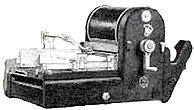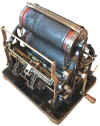FANDOM BEFORE COMPUTERSFandom, as we recognize it today, started in the early '30's, before Television, never mind before computers, with Science Fiction fans. Those early fans are often referred to as the First Fandom. You can visit their website here. Star Trek fandom, starting in the late 60's, grew out of science fiction fandom, and it was Trek fandom that gave birth to modern media fandoms like Starsky & Hutch. While fan conventions and fanzines had existed since First Fandom, they become better known due to the immense popularity of Star Trek. Fanzines, during the Trek era, went from being cheaply produced mimeographed copies of fan writing to more sophisticated privately published books, with silk-screened original sophisticated art and well-written stories with professional-level editing. Many of those experienced authors and editors left Trek for Starsky & Hutch in the late seventies and eighties, bringing all their skills to bear in this new fandom. The advent of the computer, which made producing the master copy of a zine much easier than typing clean copy for offset printing or cutting mimeo stencils, and more available (and cheaper) photocopying techniques made it even easier to produce zines, but few computer-generated zines would be as beautiful or sophisticated as some of the early S&H zines. Since many newer fen have never even seen a zine, never mind one of the older mimeo or offset printed zines, a little history can make some of these now obscure terms more relevant to digital-age fen. If you would like more information on this topic, just let me know. Flamingo |
|
|
|
The mimeograph machine (commonly abbreviated to mimeo) or stencil duplicator was a printing machine that was far cheaper per copy than any other process in runs of several hundred to several thousand copies. It was not capable of photocopying a document, as a special stencil had to be prepared by hand. Popular until the early 1990s, especially in the preparation of tests and notes for use in classrooms, it has been largely supplanted by photocopying and offset printing. It used waxed tissue paper "stencils". In practice the floppy wax sheet was backed by carbon paper and a stiff card, bound together at the top. These were placed in a typewriter to create the original. The typewriter ribbon action had to be disabled so that the bare, sharp type element struck the stencil; the impact of the typewriter key displaced the wax, making the tissue paper permeable to the oil-based ink. In the process the carbon paper produced a proof on the card backing. A special ball-tipped stylus could be used to cut stencils by hand against a patterned plastic card, but one had to write carefully or else a loop would likely tear a hole in the tissue paper, resulting in a black blob being printed. Mistakes could be corrected by applying "correction fluid" (wax dissolved in a solvent; known as "corflu" and "obliterine", the latter being a former Australian trademark) with a small brush, then re-typing over it. The stencil was wrapped around the drum of the (manual or electrical) machine which was filled with ink. When a blank sheet of paper was drawn between the rotating drum and a pressure roller, ink was forced out through the marks on the stencil. The paper had a surface texture like bond paper, and the ink was usually black, although green and red inks were available. If one put the stencil on the drum wrong-side-out, one's copies came out mirror-imaged. The process was messy, and ink would often get on one's hands and the pressure roller. In addition the striking surface of the letters on the typewriter would quickly become clogged with wax; the closed letter forms, such as "o" or "b" making a stencil cut that resulted in black blobs instead of white space in the center. |
| Gestetner stencil duplicating machines had two drums instead of the usual one drum. The stencil was attached to a band around the two drums. | |


